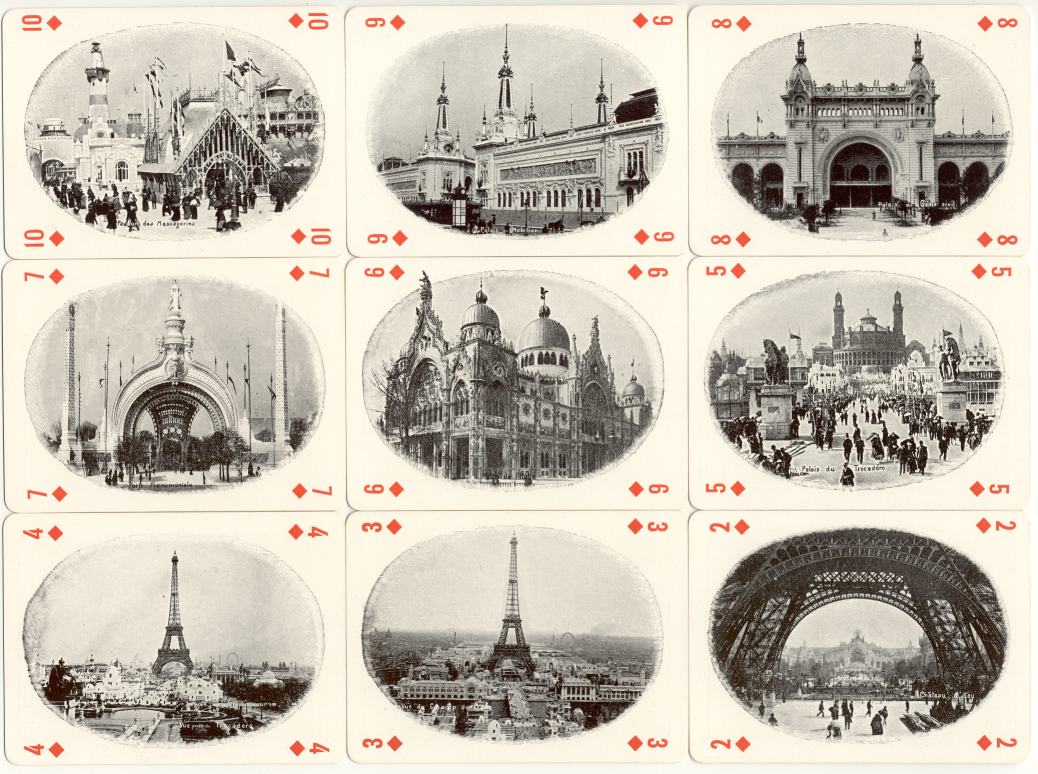
PARIS WORLD EXPOSITION 1900
-3-
Note that only the K's, Q's and J's of each suit bear the maker's name and country. On the black suits this is printed in black, here and on the Hearts in red.
Here below: the Water Palace, the Palace of
Asian Russia and the Palace of National Products
|
The Turkish Palace |
Architecture & Attractions The exhibition site could be entered via a main gate with 36 entrances. The "Porte Monumentale" (see 7 of Diamonds), also known as the "Porte Binet", after its architect, was an example of richly ornamented scenic architecture which had a major influence in shaping the exposition's overall appearance. The hall consisted of three arches connected in a triangle, covered by a dome roof of 500 square meters in size. Two minarets of 35 meters in height flanked the main arch for lighting purposes. A tower emerged from the dome like a bud, and the host city of Paris was represented at the top of this tower in the form of an allegorical female figure by Paul Moreau-Vauthier (depicted on the joker). From Paulin's Chateau d'Eau ("Water
Palace", see Ace of
Diamonds) sprang a waterfall, flowing against the backdrop of a lavishly
ornamented reinforced concrete facade into various small tubs located in
a broad basin to set off water attractions. Plastic human and animal
figures animated the artificial rocks and grottos. Close behind this
spectacle, which was illuminated at night, was the Palais de
l'Electricité‚ which was crowned by an iron structure of stars
shining out to all sides. The daytime perspective effect was intensified
by electrical illumination at night and, together with the illuminated
water effects, transformed the Champs de Mars into an atmospheric sea of
light. |
|
For the most part, the technical innovations were employed to create an artificial other-worldly atmosphere by means of kaleidoscopic impressions. A vivid model was even found for the universe, on the square in front of the Eiffel Tower (see page 5). Three spheres of 46, 36 and 8 meters diameter enclosed one inside the other produced a giant globe installed in a structure of 60 meters in height. The structure was called "La Globe Celeste", the Celestial Globe. The outer layer of this globe symbolized the universe, the middle layer the stellar system and the inner layer the earth. Via a spiral staircase, visitors were able to climb up to the North Pole, from where they could enjoy a view of the painted, but nevertheless moving, firmament, accompanied by celestial organ music by Saint-Saëns. A mechanical construction which moved the spherical shells in relation to one another in accordance with the planetary orbits was responsible for the kinetic effect. |
|

Top row: the Palace
of Transport, the Palace of Furniture and the Palace of Civil Spirit.
Middle
row: the Monumental Entrance, the Italian Palace and the Trocadero Palace.
Bottom
row: 3 views of the Eiffel tower, entitled View from the Trocadero, View
of the Champ de Mars and Water Palace.